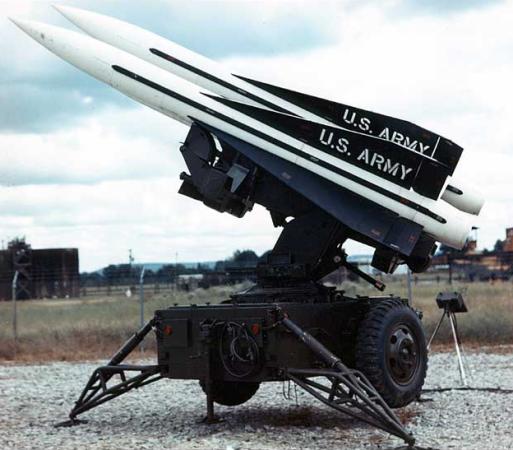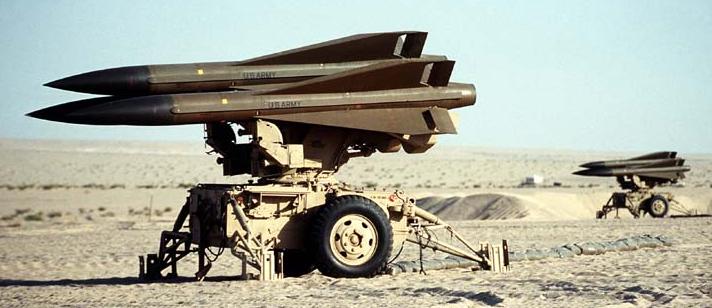Raytheon SAM-A-18/M3/MIM-23 Hawk
The Hawk was the first mobile medium-range guided anti-aircraft missile deployed by the U.S. Army, and was the oldest SAM system still in use by U.S. armed forces in the late 1990s.
Development studies for a semi-active radar homing medium-range surface-to-air missile system were begun by the U.S. Army in 1952 under the designation SAM-A-18 Hawk (Homing All the Way Killer). In July 1954, development contracts were awarded to Raytheon for the missile, and to Northrop for launcher, radars, and fire-control system. The first launch of an XSAM-A-18 test missile occurred in June 1956, and the initial development phase was completed in July 1957. By that time, the Hawk had been redesignated as Guided Missile, Aerial Intercept, XM3 (and XM3E1). Initial Operational Capability of the M3 Hawk was achieved with the U.S. Army in August 1959, and in 1960 the M3 was also fielded by U.S. Marine Corps units. The Hawk system was used by many NATO and other countries, and the missile was license-built in Western Europe and Japan. There were two training versions of the original Hawk missile, designated XM16 and XM18.
The M3 Hawk surface-to-air missile is powered by an Aerojet General M22E8 dual-thrust (boost/sustain) solid-propellant rocket motor, and is controlled in flight by its large triangular fins with trailing-edge control surfaces. It is armed with a 54 kg (119 lb) high-explosive blast-fragmentation warhead, which is equipped with both impact and radar proximity fuzes. The missile is guided by an X-band CW (Continuous Wave) monopulse semi-active radar seeker, and has an effective engagement range of 2-25 km (1.25-15 miles). A Hawk unit uses several different ground radars and control systems. The radar systems include the AN/MPQ-35 C-band PAR (Pulse Acquisition Radar) for high/medium-altitude threat detection, the AN/MPQ-34 CWAR (Continuous Wave Acquisition Radar) for low-level threat detection, the AN/MPQ-33 (or -39) HPI (High-Power Illuminator) which tracks designated targets and provides target illumination for the missile's seeker, and the AN/MPQ-37 ROR (Range Only Radar) which is a K-band pulse radar to provide ranging data when the other radars are jammed by countermeasures (the ROR reduces jamming vulnerability by transmitting only when designated).
 |
| Photo: U.S. Army |
| MIM-23A |
The Hawk missiles are transported on and launched from M192 triple-missile towed launchers. In 1967, the U.S. Army tested a self-propelled Hawk ("SP-HAWK") system, which mounted the launchers on tracked M727 (modified M548 transports) vehicles. The first Hawk units were equipped with SP-HAWK in 1969, but the system is no longer in service.
 |
| Photo: U.S. Army |
| MIM-23A (on M727) |
In June 1963, all Hawk missiles were redesignated in the MIM-23 series as follows:
| Old Designation | New Designation |
|---|---|
| XM3 | XMIM-23A |
| M3 | MIM-23A |
| XM16 | XMTM-23B |
| XM18 | XMTM-23C |
The XMTM-23B/C designations were short-lived, however, and the B/C suffix letters were later reused for improved Hawk missiles.
To counter advanced low-altitude threats, the Army began a Hawk Improvement Program (HAWK/HIP) in 1964. This involved numerous upgrades to the Hawk system, including the addition of a digital data processing central information coordinator for target processing, threat ordering, and intercept evaluation. The AN/MPQ-35 PAR, AN/MPQ-34 CWAR, AN/MPQ-33/39 HPI, and AN/MPQ-37 ROR were replaced by upgraded variants designated AN/MPQ-50, AN/MPQ-48, AN/MPQ-46, and AN/MPQ-51, respectively. The Hawk missile itself was upgraded to MIM-23B I-HAWK (Improved Hawk) configuration. The MIM-23B had a larger 74 kg (163 lb) blast-fragmentation warhead, a smaller and improved guidance package, and a new M112 rocket motor. The I-HAWK system was declared operational in 1971, and by 1978 all U.S. Hawk units had converted to the new standard. The effective range envelope of the MIM-23B is extended to 1.5-40 km (5000 ft - 25 miles) at high altitude (2.5-20 km (8200 ft - 12.4 miles) at low altitude), and minimum engagement altitude is 60 m (200 ft). There is also a training version of the I-HAWK designated MTM-23B. The XMEM-23B is a variant with a full telemetry equipment for test and evaluation purposes.
 |
| Photo: U.S. Army |
| MIM-23 (exact model unknown) |
Beginning in 1977, the U.S. Army started an extensive multi-phase Hawk PIP (Product Improvement Plan), mainly intended to improve and upgrade the ground equipment. PIP Phase I involved replacement of the CWAR with the AN/MPQ-55 Improved CWAR (ICWAR), and the upgrade of the AN/MPQ-50 PAR to Improved PAR (IPAR) configuration by the addition of a digital MTI (Moving Target Indicator). The first PIP Phase I systems were fielded in 1979. PIP Phase II, developed from 1978 and fielded between 1983 and 1986, upgraded the AN/MPQ-46 HPI to AN/MPQ-57 standard by replacing some tube electronics with modern solid-state circuits, and added a TAS (Tracking Adjunct System). The TAS, designated OD-179/TVY, is an electro-optical (TV) tracking system to increase Hawk operability and survivability in a high-ECM environment. The PIP Phase III development was started in 1983, and was first fielded by U.S. forces in 1989. Phase III is a major upgrade which significantly enhanced computer hard- and software for most components (new CWAR is designated AN/MPQ-62), added single-scan target detection capability, and upgraded the HPI to AN/MPQ-61 standard by addition of a Low-Altitude Simultaneous Hawk Engagement (LASHE) system. LASHE allows the Hawk system to counter saturation attacks by simultaneously intercepting multiple low-level targets. The ROR is no longer used by Phase III Hawk units.
The following table summarizes the designations of the main radars of the Hawk air-defense system:
| System Configuration | PAR | CWAR | HPI | ROR |
|---|---|---|---|---|
| Basic Hawk | AN/MPQ-35 | AN/MPQ-34 | AN/MPQ-33/39 | AN/MPQ-37 |
| Improved Hawk | AN/MPQ-50 | AN/MPQ-48 | AN/MPQ-46 | AN/MPQ-51 |
| PIP Phase I | AN/MPQ-55 | |||
| PIP Phase II | AN/MPQ-57 | |||
| PIP Phase III | AN/MPQ-62 | AN/MPQ-61 | (n/a) |
The MIM-23B Hawk missile was improved in parallel with the PIP upgrades. The MIM-23C, introduced around 1982, has improved ECCM capabilities. The MIM-23D is similar to the MIM-23C, but I don't have any further details. The official source [5] describes it plainly as an "upgraded MIM-23C", but this is simply a standard phrase used for subsequent versions and could mean anything, including a non-tactical model used for live training. The telemetry-equipped test and evaluation model of the MIM-23C/D is designated MEM-23C.
The MIM-23E and MIM-23F, introduced in 1990, are developments of the MIM-23C and MIM-23D, respectively, with an improved guidance section for low-level engagements in high-clutter/multi-jamming environments. The MEM-23D is the telemetry-equipped test and evaluation model of the MIM-23E/F.
The MIM-23G and MIM-23H are variants of the MIM-23E and MIM-23F, respectively, with a new body section assembly. The corresponding test and evaluation missile is the MEM-23E.
 |
| Photo: U.S. Army |
| MIM-23 (exact model unknown) |
In 1991, the USMC successfully demonstrated the use of a modified Lockheed Martin AN/TPS-59 tactical long-range radar system to search and track Theater Ballistic Missiles (TBM) in conjunction with a Hawk fire-control unit. The AN/TPS-59(V)3 radar can track targets at up to 475 km (295 miles) range and 150 km (90 miles) altitude. Although no actual firing took place, these tests prompted the USMC to upgrade its Hawk units with an anti-TBM capability. The MIM-23G/H Hawk missiles were upgraded to Enhanced Lethality Missile configuration, designated MIM-23K and MIM-23J, respectively (note "reversed" suffix letters). The MIM-23J/K has a new high-grain fragmentation warhead and new fuzing circuitry to make it effective against ballistic missiles, and in 1994, several intercepts of MGM-52 Lance short-range ballistic missiles were successful. The MIM-23L and MIM-23M missiles have the new fuzing circuits of the MIM-23K and MIM-23J, respectively, but don't have the latter's new warhead. The telemetry-equipped test and evaluation model of the MIM-23J/K/L/M missiles is designated MEM-23F.
The following table summarizes the designations of the developments of the MIM-23B I-HAWK missile, and the corresponding test and evaluation versions. Because the MEM versions use sequential suffix letters, and each MEM variant corresponds to several MIM missiles, the letters for MIM and MEM versions are "out-of-sync".
| Type of Missile | Tactical Model | T&E Model | |
|---|---|---|---|
| Basic I-HAWK | MIM-23B | XMEM-23B | |
| Improved ECCM | MIM-23C | MIM-23D | MEM-23C |
| Low-level/multi-jamming capability | MIM-23E | MIM-23F | MEM-23D |
| New body section | MIM-23G | MIM-23H | MEM-23E |
| New warhead + fuzing (anti-TBM) | MIM-23K | MIM-23J | MEM-23F |
| New fuzing only, old warhead | MIM-23L | MIM-23M | |
The U.S. Army also used the MIM-23K missile for a brief period, but not in the anti-TBM role. The last active Army Hawk unit was deactivated in 1994, and the last Army National Guard units disposed of the Hawk system in the 1996/97 time frame. The Hawk has been replaced in U.S. Army service by the MIM-104 Patriot and FIM-92 Stinger (and Stinger-based systems like Avenger) missiles for medium- and short-range air-defense, respectively.
The MIM-23K missile and AN/TPS-59(V)3 radar was operational with USMC units from 1995 onwards. Beginning in 1998/99 the USMC started to phase out the Hawk to replace it with the FIM-92 Stinger (leaving some gap in the medium-range air-defense capabilities of the USMC). By 2002, the Hawk was no longer in service with the Marine Corps.
Including foreign production, more than 40000 MIM-23 Hawk missiles of all versions were built.
Specifications
Note: Data given by several sources show slight variations. Figures given below may therefore be inaccurate!
Data for MIM-23A/B:
| MIM-23A | MIM-23B | |
|---|---|---|
| Length | 5.08 m (16 ft 8 in) | 5.03 m (16 ft 6 in) |
| Finspan | 1.19 m (3 ft 11 in) | |
| Diameter | 37 cm (14.5 in) | |
| Weight | 584 kg (1290 lb) | 635 kg (1400 lb) |
| Speed | Mach 2.5 | |
| Ceiling | 13700 m (45000 ft) | 17700 m (58000 ft) |
| Range | 25 km (15 miles) | 40 km (25 miles) |
| Propulsion | Aerojet M22E8 dual-thrust solid-fueled rocket | Aerojet M112 dual-thrust solid-fueled rocket |
| Warhead | 54 kg (119 lb) blast-fragmentation | 74 kg (163 lb) blast-fragmentation |
Main Sources
[1] Bill Gunston: "The Illustrated Encyclopedia of Rockets and Missiles", Salamander Books Ltd, 1979
[2] R.T. Pretty, D.H.R. Archer (eds.): "Jane's Weapon Systems 1972-73", Jane's, 1973
[3] Bernard Blake (ed.): "Jane's Weapon Systems 1987-88", Jane's, 1988
[4] Hajime Ozu: "Missile 2000 - Reference Guide to World Missile Systems", Shinkigensha, 2000
[5] "DOD 4120.15-L: Model Designation of Military Aerospace Vehicles", Department of Defense, 1998
[6] Redstone Arsenal Historical Information Website
[7] HAWK Site Denmark (originally at http://www.hawk.dk/, now dead link (31 March 2004))
Back to Current Designations Of U.S. Unmanned Military Aerospace Vehicles
Back to Directory of U.S. Military Rockets and Missiles
Last Updated: 20 November 2025